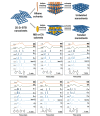[Preparation and application of chromatographic stationary phase based on two-dimensional materials]
- PMID: 38845513
- PMCID: PMC11165387
- DOI: 10.3724/SP.J.1123.2024.01022
[Preparation and application of chromatographic stationary phase based on two-dimensional materials]
Abstract
The stationary phase is the heart of chromatographic separation technology and a critical contributor to the overall separation performance of a chromatographic separation technique. However, traditional silicon-based materials designed for this purpose usually feature complex preparation processes, suboptimal permeability, pronounced mass-transfer resistance, and limited pH-range compatibility. These limitations have spurred ongoing research efforts aimed at developing new chromatographic stationary phases characterized by higher separation efficiency, adaptable selectivity, and a broader scope of applicability. In this context, the scientific community has made significant strides toward the development of new-generation materials suitable for use as chromatographic stationary phases. These materials include carbon-based nanomaterial arrays, carbon quantum dots, and two-dimensional (2D) materials. 2D-materials are characterized by nanometer-scale thicknesses, extensive specific surface areas, distinctive layered structures, and outstanding mechanical properties under standard conditions. Thus, these materials demonstrate excellent utility in various applications, such as electrical and thermal conductivity enhancements, gas storage and separation solutions, membrane separation technologies, and catalysis. Graphene, which is arguably the most popular 2D-material used for chromatographic separation, consists of a 2D-lattice of carbon atoms arranged in a single layer, with a large specific surface area and efficient adsorption properties. Its widespread adoption in research and various industries is a testament to its versatility and effectiveness. In addition to graphene, the scientific community has developed various 2D-materials that mirror the layered structures of graphene, such as boron nitride, transition-metal sulfides, and 2D porous organic frameworks, all of which offer unique advantages. 2D porous organic frameworks, in particular, have received attention because of their nanosheet morphology, one-dimensional pores, and special interlayer forces; thus, these frameworks are considered promising candidate chromatographic stationary phase materials. Such recognition is especially true for 2D-metal organic frameworks (MOFs) and 2D-covalent organic frameworks (COFs), which exhibit low densities, high porosities, and substantial specific surface areas. The modifiability of these materials, in terms of pore size, shape, functional groups, and layer-stacking arrangements allows for excellent separation selectivity, highlighting their promising potential in chromatographic separation. Compared with their three-dimensional counterparts, 2D-MOFs feature a simple pore structure that offers reduced mass-transfer resistance and enhanced column efficiency. These attributes highlight the advantages of 2D-MOF nanosheets as chromatographic stationary phases. Similarly, 2D-COFs, given their high specific surface area and porosity, not only exhibit great thermal stability and chemical tolerance but also support a wide selection of solvents and operational conditions. Therefore, their role in the preparation of chromatographic stationary phases is considered highly promising. This review discusses the latest research developments in 2D porous organic framework materials in the context of gas- and liquid-chromatographic stationary phases. It introduces the synthesis methods for these novel materials, elucidates their retention mechanisms, and describes the applications of other 2D-materials, such as graphene, its derivatives, graphitic carbon nitride, and boron nitride, in chromatography. This review aims to shed light on the promising development prospects and future directions of 2D-materials in the field of chromatographic separation, offering valuable insights into the rational design and application of new 2D-materials in chromatography.
自2004年首次报道以来,二维材料因具有纳米级厚度、高比表面积、独特的层状结构和优异的机械性能等特点,受到了广泛关注。在导电、导热、气体存储和分离、膜分离以及催化等领域,二维材料均展现出了广阔的应用前景;其中,最为知名的二维材料是石墨烯,其是由单层碳原子构成的二维晶格结构,拥有较大的比表面积和优良的吸附性能,因而备受青睐。除此之外,二维材料还包括类石墨相氮化碳、氮化硼、过渡金属硫化物等。随着网状化学的不断发展,二维多孔框架材料逐渐受到关注,这类材料拥有纳米片状的形态、一维的孔道结构以及特殊的层间作用力,具有作用力丰富和可设计性强等优势,在色谱分离领域展现出了巨大的应用潜力。本文首先简要介绍了二维材料的合成方法与分离机理,随后着重介绍了近年来二维多孔框架材料在气相色谱及液相色谱固定相应用方面的最新研究进展。同时,本文也涉及了一些其他二维材料在色谱领域的应用,并对二维材料在色谱分离领域的发展前景进行了展望,期望为基于二维材料的色谱分离材料设计及应用提供参考。
Keywords: chromatographic stationary phase; covalent organic frameworks (COFs); metal organic frameworks (MOFs); review; two-dimensional materials.
Figures
References
-
- Ainali N M, Kalaronis D, Kontogiannis A , et al.. Sci Total Environ, 2021, 794: 148725 - PubMed
-
- Young G M, Lurie I S. J Sep Sci, 2022, 45(1): 369 - PubMed
-
- Lynch K B, Ren J, Beckner M A , et al.. Anal Chim Acta, 2019, 1046: 48 - PubMed
-
- Polyakova A, van Leeuwen S, Peters R. Anal Chim Acta, 2022, 1234: 340098 - PubMed
Publication types
LinkOut - more resources
Full Text Sources




